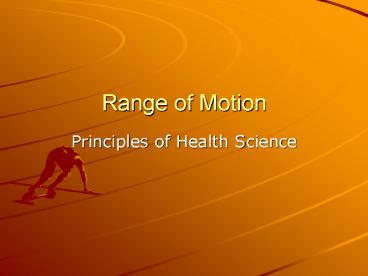Range of Motion - PowerPoint PPT Presentation
1 / 12
Title:
Range of Motion
Description:
Range of Motion Principles of Health Science Range of Motion: the complete extent of movement of which a joint is capable A. Used when doing routine activities such ... – PowerPoint PPT presentation
Number of Views:168
Avg rating:3.0/5.0
Title: Range of Motion
1
Range of Motion
- Principles of Health Science
2
- Range of Motion the complete extent of movement
of which a joint is capable - A. Used when doing routine activities such as
bathing eating and dressing uses muscles that
keep many joints in effective range of motion
3
- B. Purpose of Range of Motion
- a. To prevent problems caused by a lack of
movement - b. To prevent problems caused by inactivity
- 1.contractures a tightening and shortening of a
muscle e.g. foot drop - 2. Muscles may atrophy (shrink) when they are not
used - 3. Joints become stiff
- 4. Blood clots and decubitus ulcers may develop
4
(No Transcript)
5
- C. Active Range of Motion movements performed by
the patient without help - D. Passive Range of Motion movement cannot be
performed by the patient and the health care
worker moves each joint through its range of
motion - E. Active assistive Range of Motion the patient
does the exercises with some assistance from
another person
6
General Rules for ROM
- 1. Use good body mechanics raise the bed to your
waist level if the patient is in bed - 2. Expose only the body part being exercised
- 3. Explain to the patient what you are going to
do and teach the patient how to do them
7
General Rules of ROM
- 4. Support the extremity being exercised (place
hands under the extremity supporting the joint
above and the joint below the one you are
exercising) - 5.Move each joint until there is resistance but
not pain
8
- 6.Move each joint slowly, smoothly and gently
- 7.Return the joint to a neutral position after
the movement - 8.Repeat each exercise 3-5 times
9
Joint Movement
- 1. Abduction moving a body part away from the
midline - 2. Adduction moving a body part toward the
midline - 3. Flexion bending a body part
- 4. Extension straightening a body part
- 5. Hyperextension excessive straightening of a
body part - 6. Rotation moving in a circle at a joint
- 7. Pronation turning a body part downward
10
Joint Movement contd
- 8. Supination turning a body part upward
- 9. Inversion turning a body part inward
- 10. Eversion turning a body part outward
- 11. Dorsiflexion bending backward
- 12. Plantar Flexion bending forward
- 13. Radial deviation moving toward the thumb
side - 14. Ulnar deviation moving toward the little
finger side
11
(No Transcript)
12
- The End































